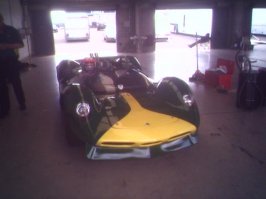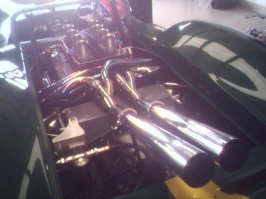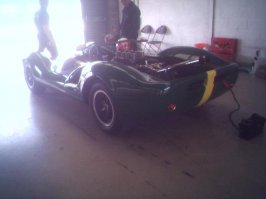To correct what some were saying earlier regarding the 1991 24 Hours of Le Mans:
* Jaguar and Mercedes did not fail to qualify for Le Mans with the newer XJR-14 and C291. XJR-14 #4 set the second fastest qualifying time behind a Mercedes C11. The XJR-14 was withdrawn because the team did not feel the Cosworth HB V8s could last 24 hours. Mercedes practiced with a C291 but withdrew it before it could set a qualifying time, again because of worries over the Flat-12s they were running (for good reason, the blocks were bad). Peugeot was forced to run their 905s because they had no older car to fall back on, and Le Mans was still part of the World Sportscar Championship season and hence was a points event. The older XJR-12s and C11s had already been entered before practice even began because of the known reliability issues and the pressing need for the teams to earn points.
* The Jaguar XJR-12 and Mercedes C11 were not obsolete. The XJR-12, with a naturally aspirated V12, debuted at the 1990 24 Hours of Daytona as a more reliable endurance variant to the turbocharged V6 XJR-10 which ran in IMSA and XJR-11 which ran in WSC. The XJR-12 had also won the 1990 24 Hours of Le Mans. The Mercedes C11 debuted in the second round of the WSC in 1990 as well, and in fact was still being run during the three races prior to Le Mans in 1991. The 787 on the other hand also debuted in 1990, running just the JSPC series before the 787B finally entered the World Sportscar Championship in 1991.
* Looking at the rest of the 1991 World Sportscar Championship season, Mazda's next best result outside of Le Mans was a 5th at the Nurburgring (with the 787, not a 787B). They finished the championship in fifth, behind Mercedes, Jaguar, Peugeot AND the privateer Euro Racing team who was running year-old Spice chassis and a Ford Cosworth V8 based on the 1960s DFV. Mazda also finished a mere four points ahead (thanks to their Le Mans win points) of Kremer Racing who was running Porsche 962s which had started life in 1984.
* Yes, reliability did play into the hands of Mazda, but it was not simply the other teams being distracted. Mazda's plan for Le Mans was to designate a rabbit and a tortoise. One car would run as quickly as possible to attempt to get competitors to chas it and break, while the second car would talk a calmer pace to try and survive until the end. It simply happened that Mazda's rabbit, which was not intended to survive, did. Mazda's tortoise ended up where expected after the competitors broke, only five laps behind the leading Jaguar. Mazda used this tactic again in 1992 in the Jaguar-built Judd-engined MXR-01s, and again briefly led the race, but the cars did not last as they had in 1991.
* Rotaries were not banned after Mazda's 1991 win. The 1992 World Sportscar Championship engine regulations had been announced in 1990, requiring everyone to run naturally aspirated engines of 3500 cc, identical to Formula One engines. Mazda's rotary, classified under FIA formulas as a 2.6 liter, obviously would not have been able to compete with 3.5L engines which revved as high if not higher than the R26B rotary. Mazda knew the regulations were coming and 1991 was planned from the start to be the final year for the rotaries. The 787B could have run Le Mans (but not other WSC events) in 1992 under the "C2" class, which Toyota opted to run their older turbocharged 92C-Vs in alongside the "C1" glass TS010s, but Mazda chose instead to concentrate on the 3.5L MXR-01s.
At the same time, Mazda moved to the Camel GT Championship with the RX-792P which also ran the R26B 4-rotor. The cars notoriously caught fire several times because their exhaust could not handle the rotary's heat. The season best was a second at Watkins Glen, five laps behind the Toyota Eagle MkIII which was running a turbocharged 4-cylinder. Mazda withdrew from prototypes after 1992, cancelling the MXR-01 and RX-792Ps together.
After the World Sportscar Championship collapsed at the end of 1992 and Group C and the Camel GTP championship died off in 1994, Mazda entered Kudzu-built LMPs from 1995 to 1997 at Le Mans, with finishes of 7th, 25th (last finisher), and 17th (last finisher), running both a 3-rotor and R26B 4-rotor. In 2002, AutoExe entered a WR LMP with the R26B 4-rotor, which failed after 5 laps.
Mazda's most recent rotary prototypes were the Courage-Mazdas of BK Motorsports in the ALMS from 2005 - 2006 running a production-based 2-rotor. 2005 championship position of third with one "win", claimed by the fact that they were the last LMP2 car to break and not finish, and a 2006 season which saw the team miss half the races because their car was too badly damaged. Mazda cancelled the rotary program and now runs a turbocharged Inline-4 in prototypes in 2007.






 WTF? And their tranny tuning isn't played with at all..so the Mazda 787B tops off early, and the TSO20 can't make it any faster than 250-ish mph! 👎
WTF? And their tranny tuning isn't played with at all..so the Mazda 787B tops off early, and the TSO20 can't make it any faster than 250-ish mph! 👎 Yeah, like I said...a real disappointment.
Yeah, like I said...a real disappointment.
